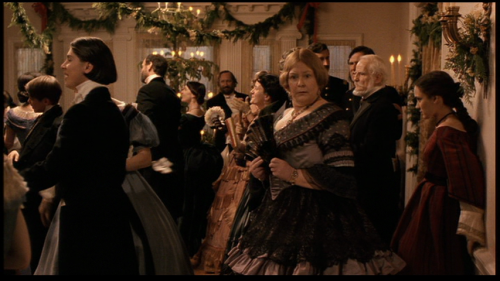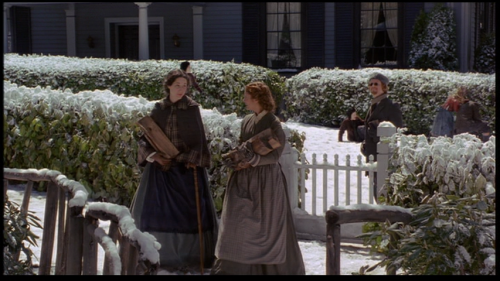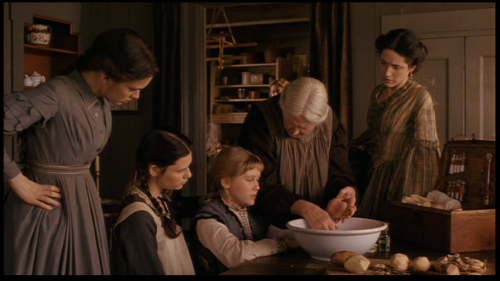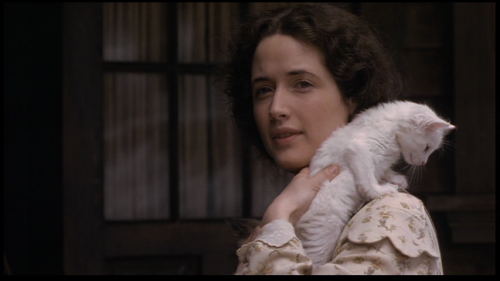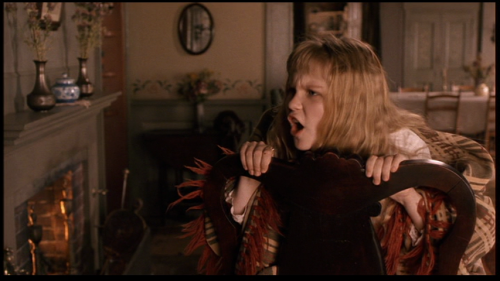I pick up my deep dive as the story moves into spring. This is a perfect opportunity to praise Thomas Newman’s score, as the theme for spring is particularly sublime.
I acquired the soundtrack on CD when I was in college and have almost as much attachment to the score as I do to the movie itself.
Meg is preparing to go to Boston to attend Sally Moffat’s coming out with the help of the whole family.
Jo’s looking for Meg’s glove, which means it wasn’t a winter glove at all, if she needs it to wear to a fancy ball. It will remain a mystery how Mr. Brooke obtained it.
We get a proper introduction to Aunt March in this scene, where she is the equivalent of a disapproving mother-in-law to Mrs. March (Marmee). Before we had only seen her asleep while Jo read to her.

What I like about this scene is when Aunt March says that Meg cannot go without gloves because “the Moffats are society,” and Marmee says “You’re absolutely correct. Meg may borrow mine.” Even though Marmee is not interested in raising girls in strict compliance with society’s expectations, she picks her battles – especially where Meg is concerned. She must know that doing things properly is important to Meg, so it’s important to Marmee too.
They do a nice job setting up the fanciness of this ball, with an overhead shot of a maid carrying Meg’s dress up a staircase and cutting to Sally Moffat eating a delectable pastry off of a tray of them.
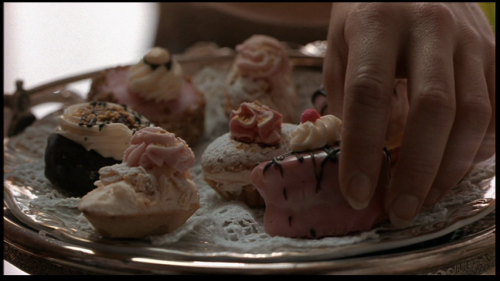
Here we are introduced to an unnamed queen bee character, who backhandedly compliments Meg’s dress. This leads into a discussion of the March family’s abolitionist and anti-child labor views. Got to love the random girl who says nothing but “This isn’t China silk?”
The queen bee character says “The poor are always with us.” I was once in a Bible study years ago where there was a verse with a similar phrase, and I said, “oh this is like when people say “the poor are always with us.” And then I had to admit, “actually, I’m not sure I’ve ever heard anyone say that before. I think just in that one scene in Little Women.” And there was a girl in the study who knew exactly what I was talking about.
“You have no corset” the French maid tells Meg, to the titters of the other girls in the room. For some reason, this reminds me of how middle grade girls seemed to monitor the bra status of other girls when I was growing up. Fun times.
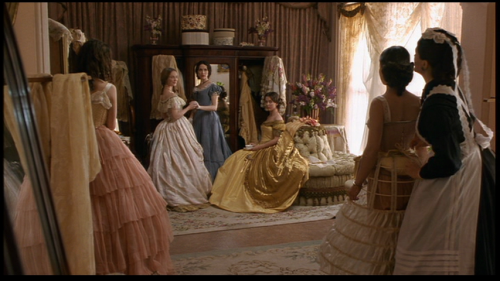
How did no one notice these children throwing things down from the balconies to the guests below? I thought this was supposed to be a fancy ball? But I guess it’s to underscore that we’ve entered a world of indulged, spoiled children.
Ugh, Laurie is so annoying in this scene when he takes Meg’s drink out of her hand and says, “I thought your family were temperance people.” No need to say that in front of other people and embarrass her. And then, when she self-consciously puts her hand to her neckline, he says something about he’s one of the few men who haven’t seen all her charms, referring to her corset-enhanced cleavage. He does apologize for it a little later, so at least it’s acknowledged that he’s behaving badly here.
Laurie and Meg have a quick heart-to-heart in private, and she confesses she just wanted to play a part. This is one of my favorite Meg scenes. She tried playing by different rules, and though it didn’t suit her, I rather like her for trying it out.
“And nothing inspires speculation more than the sight of a woman enjoying herself”. This statement from Marmee is excellent. Meanwhile, Jo is holding onto the bedpost with her hands and bare feet while her mother braids her hair. The cozy staging for these family conversations is on point.

Dang, I near about cried at this affirming talk that Marmee has with Meg. Meg seems a little afraid of criticism when she admits that it was nice to be praised and admired. But Marmee doesn’t judge her for this and then tells her “Your humor, your kindness, and your moral courage – these are the things I cherish so in you.”
“I so wish I could give my girls a more just world, but I know you will make it a better place.” *sniff* No surprise, Jo is hit by an inspiration to write after listening to these words from her mother.
“Meg, John Brooke stole your glove…don’t you think he should give it back?” Hannah the housekeeper slyly says, “T’isn’t what I think that matters.” Jo fails to see the romance in all of this.
The film reminds us that it’s still Civil War times – Marmee must travel to attend to their father who has been wounded and is at a hospital in D.C.
Okay there are so many things to say about this scene where Jo reveals she sold her hair to get money for the railway ticket:
- She’d rather cut off her hair than try to ask an unpleasant relative for money and I find this completely understandable. Most people, including myself, hate to ask for money.
- Amy’s comment “Jo, how could you?! Your one beauty!” might be the most hilarious line in the movie, followed by the next scene’s exchange – Beth, asking a sobbing Jo: “Are you thinking about father?” Jo, in a little wail: “My hair!”
- Due to repeated watchings, we noticed that there’s a moment in the hair reveal scene where Laurie muffles laughter in the background, behind Jo.
- This is where we hear the movie/book title when Marmee says, “oh how I will miss my little women.”
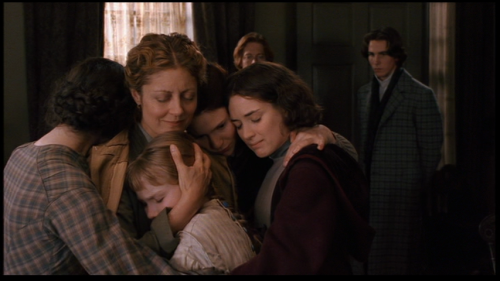
There’s a small interstitial scene here, where a pumpkin-head effigy in a suit is being dragged behind a wagon, along with tin cans, while children throw rocks at it. I don’t know if this is supposed to be referencing a particular tradition. Guy Fawkes Day/Bonfire Night appears to have been a colonial relic so it wouldn’t have been observed in the US in the 1860s. In any case, the scene is marking that it is autumn.
Jo: “I hate money!” My family always looks at my older sister here when rewatching – as I mentioned in Part One, this is something she was known for saying in her teen years.
Beth has generally been in the background of the movie until now, when she finally gets the spotlight as she helps the poor Hummel family. She looks so overwhelmed and young as Mrs. Hummel hands over a screaming, feverish baby and speaks to her in German, asking for Beth’s mother and for medicine.

In the next scene, Jo crams in a little exposition about Laurie – that he spends money on billiards and in general seems to be wasting his time in college, which must seem a slap in the face to Jo, who would love to go to college.
Hannah is a real MVP here, by quickly diagnosing Beth with scarlet fever, and instructing Amy to be sent away since she’s never had it.
There is so much groundwork laid out in this conversation between Amy and Laurie. We learn she is going to Aunt March’s, a relationship that bears fruit later. When Laurie offers to take Amy away if Aunt March is unkind, Amy asks where they would go, and he says lightly, “Paris?” which makes her smile. They will in fact both see each other in France later in the film. And finally, Amy says she would not like to die before being kissed and Laurie promises to kiss her before she dies and they both laugh. This is referenced later too.
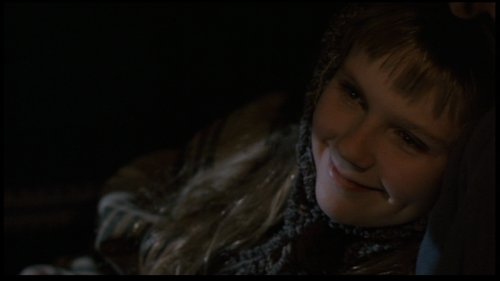
Aunt March is kind to Amy, and seems perceptive to Amy’s unspoken distress about Beth. And apparently it’s time for all the old curmudgeons to reveal their softer sides, as Mr. Lawrence, their rigid neighbor, brings in his personal physician to attend to Beth.
In this scene where Laurie says he’s sent for Mrs. March, I realized for the first time that Hannah, who is Irish, is uttering a “Hail Mary” in the background.
Marmee takes charge of the situation immediately. I always love that point in stories where the “adult that knows what to do” arrives on the scene, to everyone’s relief. Not to mention the particular solace of your parent taking care of you when you’re sick.
Cue waterworks here, when Jo comes down and sees Hannah crying and the bed cleared away, and fears the worst, but then sees Marmee and Meg sitting beside Beth and feeding her soup. Jo lays her head in Beth’s lap, and there’s something about the gesture that demonstrates how deeply Jo needs Beth.

Christmas again! And a bigger circle of celebrants – Mr. Lawrence, Aunt March, Laurie and two college friends that he introduces to shy, frail Beth when he sees her hesitate at the door due to the strangers.
The old curmudgeons continue to show they are secretly soft, as Mr. Lawrence wipes away a tear as Beth plays the new piano, and Aunt March boisterously leads the group in a second verse of Deck the Halls. You can see and hear Jo’s surprised delight as she looks at Aunt March and sings “follow me in merry measure!”
Meg: “So you don’t mind that John is poor?” Marmee: “No…I’d rather he have a house!” Yeah, that’s not a rule that would work in the 21st century for marrying, haha.
Okay, this is rude of Jo, but her face when she starts reading Meg’s love letter from Mr. Brook is hilarious.

The long-absent Mr. March finally appears! His presence will mean almost nothing in the rest of the film!
Whew! Meg and Mr. Brooke are having a proper snog in the back doorway, beautifully framed by falling snow behind them.
I always admired this scene transition where the staircase railings fade into fence railings next to Union soldiers returning at war’s end.
Meg and John Brooke get married! The wedding party sings “For the Beauty of the Earth” while they hold hands and move in a circle around the married couple. I don’t know if this a specific tradition referenced or chosen because it is very pretty.

Here too we are introduced to adult Amy, played by Samantha Mathis. This casting is probably the movie’s weakest point. Mathis does not perform the character with the same liveliness as Kirsten Dunst. While you can expect that Amy’s maturity means some shifts in personality, Mathis comes off as a bit too chilly of a snob. Some oomph is taken out of the movie with the departure of Dunst.
Uh oh, here’s the scene where Laurie proposes to Jo. My younger sister’s childhood friend Kara would watch Little Women with us, and say how much she hated Christian Bale’s deep whisper voice during this proposal. It’s not Bale’s Batman voice, but apparently it has similar polarizing effect on the audience.
Growing up, I was completely convinced by Jo’s argument about why they shouldn’t be married. It wasn’t until I watched this with college friends that I was even aware that people would be upset that these two don’t end up together. And it was even later, when I learned that Alcott’s original readers also raised an outcry that Jo and Laurie don’t end up together.

Amy comes in to the room where Beth is comforting Jo and accidentally makes Jo feel even worse by announcing that Aunt March has asked Amy to accompany her to France, a trip that Jo had long anticipated. This scene frustrated me. I remember wondering why Amy brought up Europe in the first place, especially as it takes her forever to explain that she was suggesting Aunt March’s home as a place for Jo to escape to. Having it be adult Amy’s first speaking scene doesn’t help either – we have been so accustomed to Kirsten Dunst in the role.

Marmee shows her parent superpowers again by finding Jo a place to stay in New York City. Honestly, this rewatch, it’s Marmee that is coming into focus the most.

Jo’s arrival in New York City seems an appropriate place to pause. I expect Part Three to be the final installment of this deep dive, but we’ll see – I may have to stretch to four parts.






